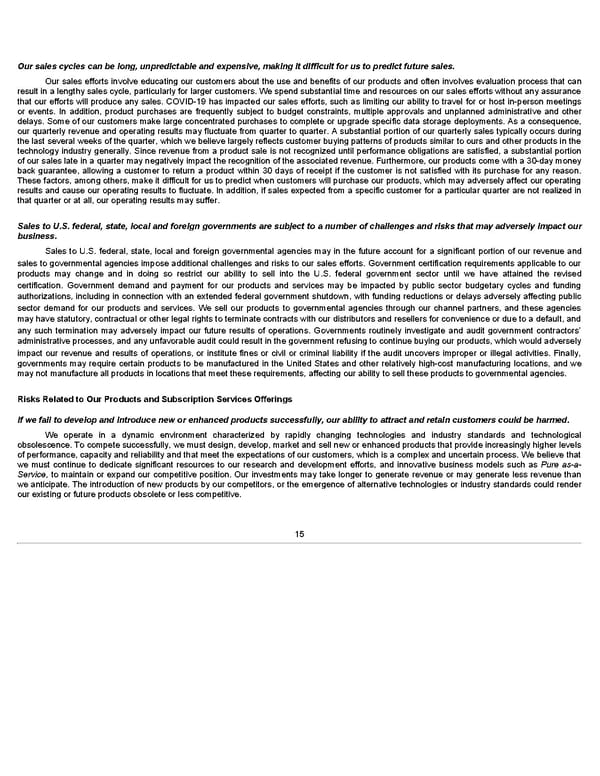Our sales cycles can be long, unpredictable and expensive, making it difficult for us to predict future sales. Our sales efforts involve educating our customers about the use and benefits of our products and often involves evaluation process that can result in a lengthy sales cycle, particularly for larger customers. We spend substantial time and resources on our sales efforts without any assurance that our efforts will produce any sales. COVID-19 has impacted our sales efforts, such as limiting our ability to travel for or host in-person meetings or events. In addition, product purchases are frequently subject to budget constraints, multiple approvals and unplanned administrative and other delays. Some of our customers make large concentrated purchases to complete or upgrade specific data storage deployments. As a consequence, our quarterly revenue and operating results may fluctuate from quarter to quarter. A substantial portion of our quarterly sales typically occurs during the last several weeks of the quarter, which we believe largely reflects customer buying patterns of products similar to ours and other products in the technology industry generally. Since revenue from a product sale is not recognized until performance obligations are satisfied, a substantial portion of our sales late in a quarter may negatively impact the recognition of the associated revenue. Furthermore, our products come with a 30-day money back guarantee, allowing a customer to return a product within 30 days of receipt if the customer is not satisfied with its purchase for any reason. These factors, among others, make it difficult for us to predict when customers will purchase our products, which may adversely affect our operating results and cause our operating results to fluctuate. In addition, if sales expected from a specific customer for a particular quarter are not realized in that quarter or at all, our operating results may suffer. Sales to U.S. federal, state, local and foreign governments are subject to a number of challenges and risks that may adversely impact our business. Sales to U.S. federal, state, local and foreign governmental agencies may in the future account for a significant portion of our revenue and sales to governmental agencies impose additional challenges and risks to our sales efforts. Government certification requirements applicable to our products may change and in doing so restrict our ability to sell into the U.S. federal government sector until we have attained the revised certification. Government demand and payment for our products and services may be impacted by public sector budgetary cycles and funding authorizations, including in connection with an extended federal government shutdown, with funding reductions or delays adversely affecting public sector demand for our products and services. We sell our products to governmental agencies through our channel partners, and these agencies may have statutory, contractual or other legal rights to terminate contracts with our distributors and resellers for convenience or due to a default, and any such termination may adversely impact our future results of operations. Governments routinely investigate and audit government contractors’ administrative processes, and any unfavorable audit could result in the government refusing to continue buying our products, which would adversely impact our revenue and results of operations, or institute fines or civil or criminal liability if the audit uncovers improper or illegal activities. Finally, governments may require certain products to be manufactured in the United States and other relatively high-cost manufacturing locations, and we may not manufacture all products in locations that meet these requirements, affecting our ability to sell these products to governmental agencies. Risks Related to Our Products and Subscription Services Offerings If we fail to develop and introduce new or enhanced products successfully, our ability to attract and retain customers could be harmed. We operate in a dynamic environment characterized by rapidly changing technologies and industry standards and technological obsolescence. To compete successfully, we must design, develop, market and sell new or enhanced products that provide increasingly higher levels of performance, capacity and reliability and that meet the expectations of our customers, which is a complex and uncertain process. We believe that we must continue to dedicate significant resources to our research and development efforts, and innovative business models such as Pure as-a- Service, to maintain or expand our competitive position. Our investments may take longer to generate revenue or may generate less revenue than we anticipate. The introduction of new products by our competitors, or the emergence of alternative technologies or industry standards could render our existing or future products obsolete or less competitive. 15
 Annua lReport Page 14 Page 16
Annua lReport Page 14 Page 16